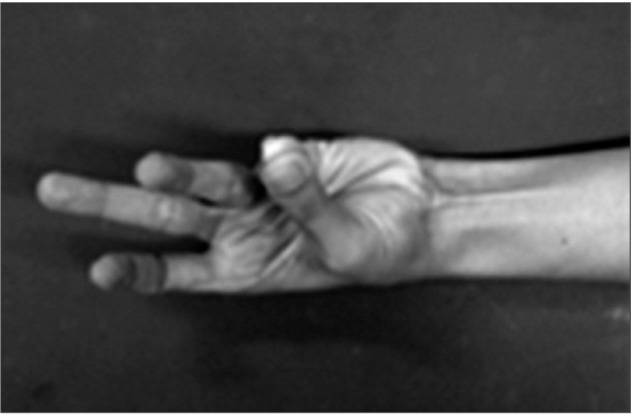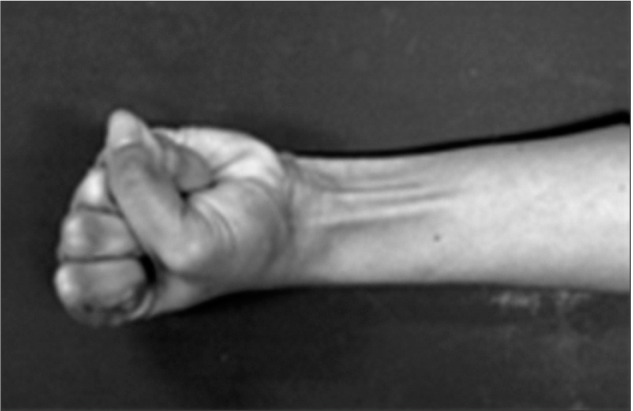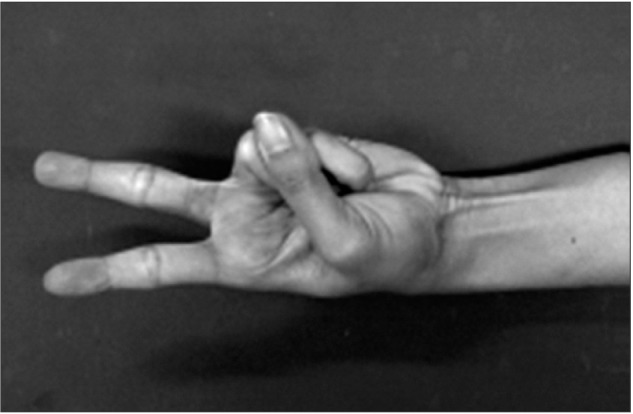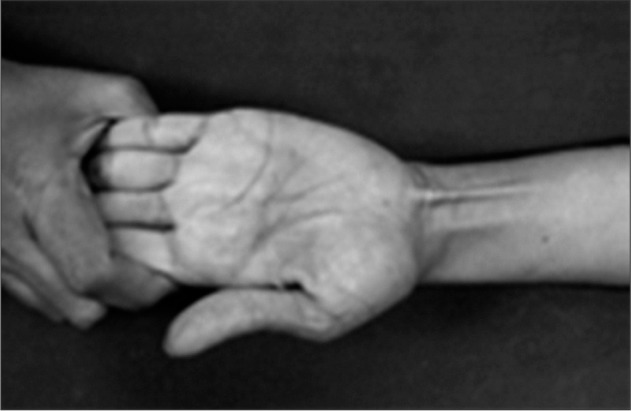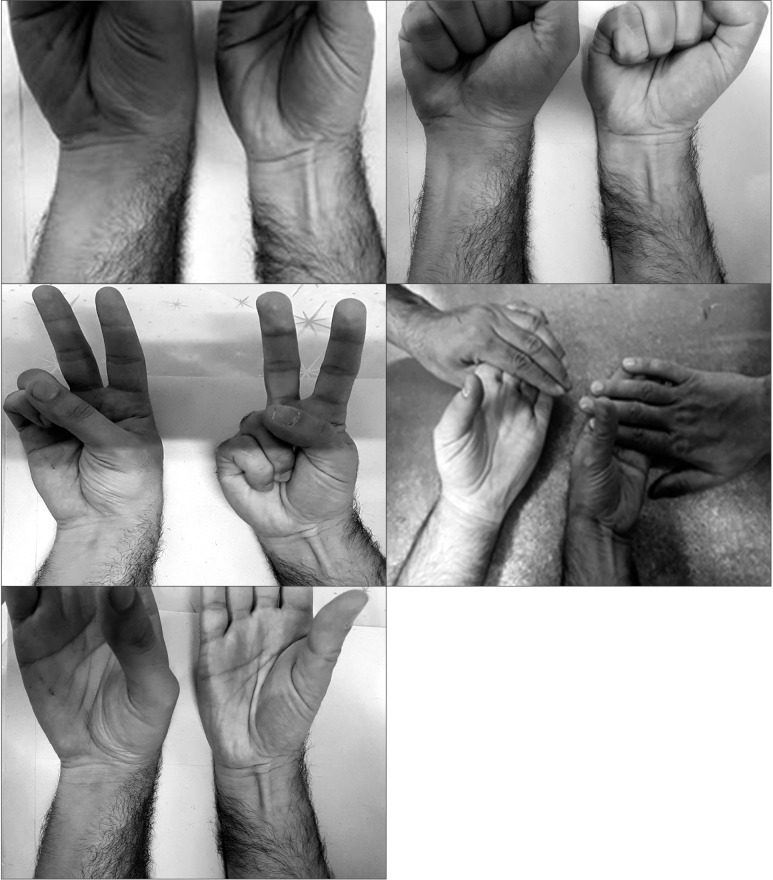Anat Cell Biol.
2018 Jun;51(2):79-84. 10.5115/acb.2018.51.2.79.
Interobserver and intraobserver reliability of different methods of examination for presence of palmaris longus and examination of fifth superficial flexor function
- Affiliations
-
- 1Deparment of Orthopedics, Kerman Neuroscience Research Center, Kerman University of Medical Sciences, Kerman, Iran.
- 2Department of Plastic and Hand Surgery, Imam Reza Hospital, AJA University of Medical Sciences, Tehran, Iran.
- 3Department of Orthopedics and Hand Surgery, Kerman Neuroscience Research Center, Kerman University of Medical Sciences, Kerman, Iran. arsaiedmd@yahoo.com
- KMID: 2421170
- DOI: http://doi.org/10.5115/acb.2018.51.2.79
Abstract
- The palmaris longus is harvested as a tendon graft in various surgical procedures. Several tests are used to assess the presence of palmaris longus tendon. In the present study, we attempted to assess the interobserver and intraobserver reliability of five of the most famous methods and also the examination of fifth superficial flexor function. Two observers, who had been trained on the tests and had practiced them, examined 105 volunteers on two separate occasions and in 1-month interval the results were recorded. The reliability of each method was assessed with Kappa measurement. Kappa ranged from 0.541 (moderate reliability) to 0.813 (almost complete agreement) for palmaris. The highest interobserver and intraobserver reliability and also the best agreement with other tests were of Schaeffer. The lowest kappa was for Thompson and the others have good to excellent reliability. Kappa for interobserver and intraobserver reliability for the fifth flexor were 0.415 and 0.500 (moderate reliability), respectively. The tests that were assessed have good reliability except for Thompson that has a moderate one. It seems that the standard test (Schaeffer) is the best method for the assessment of the absence or presence of palmaris longus. The method used for the evaluation of fifth superficial flexor variations assessment has a moderate interobserver and intraobserver reliability.
Figure
Cited by 1 articles
-
A case of potentially lethal vascular variation in association with palmaris profundus muscle
Manisha Rajanand Gaikwad, Praveen Kumar Ravi, Madhumita Patnaik
Anat Cell Biol. 2019;52(3):349-353. doi: 10.5115/acb.19.061.
Reference
-
1. Capdarest-Arest N, Gonzalez JP, Turker T. Hypotheses for ongoing evolution of muscles of the upper extremity. Med Hypotheses. 2014; 82:452–456. PMID: 24529649.2. Schaeffer JP. On the variations of the palmaris longus muscle. Anat Rec. 1909; 3:275–278.3. Thompson JW, McBatts J, Danforth CH. Hereditary and racial variations in the musculus palmaris longus. Am J Phys Anthropol. 1921; 4:205–218.4. Mishra S. Alternative tests in demonstrating the presence of palmaris longus. Indian J Plast Surg. 2001; 34:12–14.5. Pushpakumar SB, Hanson RP, Carroll S. The ‘two finger’ sign: clinical examination of palmaris longus (PL) tendon. Br J Plast Surg. 2004; 57:184–185. PMID: 15037188.6. Machhindra MV, Garg B, Tiwari V, Kotwal P. AIIMS test: a simple test to look for presence of palmaris longus. Musculoskelet Surg. 2015; 99:155–158. PMID: 25860500.7. Mahajan AL. The ‘fingers fan out’ sign: stick out your palmaris longus even better. Br J Plast Surg. 2005; 58:278–279. PMID: 15710132.8. Oudit D, Crawford L, Juma A, Howcroft A. The “four-finger” sign: to demonstrate the palmaris longus tendon. Plast Reconstr Surg. 2005; 116:691–692. PMID: 16079735.9. Kyung DS, Lee JH, Choi IJ, Kim DK. Different frequency of the absence of the palmaris longus according to assessment methods in a Korean population. Anat Cell Biol. 2012; 45:53–56. PMID: 22536552.10. Vercruyssen J, Scafoglieri A, Cattrysse E. The impact of palmaris longus muscle on function in sports: an explorative study in elite tennis players and recreational athletes. J Funct Morphol Kinesiol. 2016; 1:167–182.11. Vučinić N, Erić M, Savić M. How often absence of palmaris longus and functional deficiencyof flexor digitorum superficialis occurs? Acta Orthop Belg. 2016; 82:405–411. PMID: 27682306.12. Tan JS, Oh L, Louis DS. Variations of the flexor digitorum superficialis as determined by an expanded clinical examination. J Hand Surg Am. 2009; 34:900–906. PMID: 19410995.13. Guler F, Kose O, Turan A, Baz AB, Akalin S. The prevalence of functional absence of flexor digitorum superficialis to the little finger: a study in a Turkish population. J Plast Surg Hand Surg. 2013; 47:224–227. PMID: 23617293.14. Raouf HA, Kader GA, Jaradat A, Dharap A, Fadel R, Salem AH. Frequency of palmaris longus absence and its association with other anatomical variations in the Egyptian population. Clin Anat. 2013; 26:572–577. PMID: 23339087.15. Sim J, Wright CC. The kappa statistic in reliability studies: use, interpretation, and sample size requirements. Phys Ther. 2005; 85:257–268. PMID: 15733050.16. Cannon DL. Flexor and extensor tendon injuries. In : Canale ST, Beaty JH, editors. Campbell's Operative Orthopedics. 12th ed. St. Louis: Mosby;2013. p. 2213–2247.17. Ashouri K, Lahiji FA, Esmailijah AA, Hoseini Khameneh SM, Madadi F, Bagheri F, Rahimi M, Zandi R, Safdari F. Palmaris longus agenesis. Iran J Orthop Surg. 2011; 9:18–21.18. Sebastin SJ, Lim AY. Clinical assessment of absence of the palmaris longus and its association with other anatomical anomalies: a Chinese population study. Ann Acad Med Singapore. 2006; 35:249–253. PMID: 16710495.19. Sankar KD, Bhanu PS, John SP. Incidence of agenesis of palmaris longus in the Andhra population of India. Indian J Plast Surg. 2011; 44:134–138. PMID: 21713200.20. Sebastin SJ, Lim AY. Clinical assessment of the palmaris longus: too many newer techniques? J Plast Reconstr Aesthet Surg. 2006; 59:784–786. PMID: 16782584.21. Sankar KD, Bhanu PS, John SP. Incidence of agenesis of palmaris longus in the Andhra population of India. Indian J Plast Surg. 2011; 44:134–138. PMID: 21713200.22. Gangata H. The clinical surface anatomy anomalies of the palmaris longus muscle in the Black African population of Zimbabwe and a proposed new testing technique. Clin Anat. 2009; 22:230–235. PMID: 19173262.23. Hiz Ö, Ediz L, Ceylan MF, Gezici E, Gülcü E, Erden M. Prevalence of the absence of palmaris longus muscle assessed by a new examination test (Hiz-Ediz Test) in the population residing in the area of Van, Turkey. J Clin Exp Invest. 2011; 2:254–259.24. Kigera JW, Mukwaya S. Frequency of agenesis Palmaris longus through clinical examination: an East African study. PLoS One. 2011; 6:e28997. PMID: 22174943.25. Kigera JW, Mukwaya S. Clinical assessment of the palmaris longus: accuracy of common tests. Ann Afr Surg. 2012; 9:41–44.26. Simpson SL, Hertzog MS, Barja RH. The plantaris tendon graft: an ultrasound study. J Hand Surg Am. 1991; 16:708–711. PMID: 1880370.27. Doğan T, Celebiler O, Gürünlüoğlu R, Bayramiçli M, Numanoçlu A. A new test for superficialis flexor tendon function. Ann Plast Surg. 2000; 45:93–96. PMID: 10917107.28. Mishra S. A new test for demonstrating the action of flexor digitorum superficialis (FDS) tendon. J Plast Reconstr Aesthet Surg. 2006; 59:1342–1344. PMID: 17113514.29. Tan J, Kim CH, Lee HJ, Chen J, Chen QZ, Jeon IH. A new examination method for anatomical variations of the flexor digitorum superficialis in the little finger. Clin Orthop Surg. 2013; 5:138–144. PMID: 23730479.
- Full Text Links
- Actions
-
Cited
- CITED
-
- Close
- Share
- Similar articles
-
- Erratum: Interobserver and intraobserver reliability of different methods of examination for presence of palmaris longus and examination of fifth superficial flexor function
- Palmaris Longus in Korean
- Neurilemoma Localized in the Palmaris Longus Tendon with no Connection to the Major Nerve Trunk
- A case of potentially lethal vascular variation in association with palmaris profundus muscle
- Acute Rupture of Flexor Tendons as a Complication of Distal Radius Fracture

